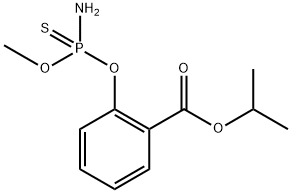Isocarbophos is a broad-spectrum organophosphorus insecticide used to control a variety of leaf-eating and soil insects on rice, fruit and other crops1-3. It can control various kinds of pests such as aphids, spider mite, borers and leaf rollers. However, it is an insecticide without EU regulatory approval for use. It has a moderate level of water solubility. It has caused environmental pollution in many areas but little is known regarding its environmental fate1-2. It is highly toxic to mammals and also has a high potential for bioaccumulation. It is an acetyl cholinesterase inhibitor and a neurotoxin1.
- http://sitem.herts.ac.uk/aeru/ppdb/en/Reports/987.htm
- Rong, L., et al. "Isolation of an isocarbophos-degrading strain of Arthrobacter sp. scl-2 and identification of the degradation pathway." Journal of Microbiology & Biotechnology 19.11(2009):1439.
- http://www.chemchina.com.cn/slden/cpyfw/ppysb/jscg/webinfo/2012/06/1342611935451309.htm
Isocarbophos is an organophosphorus pesticide residue found in spicy foods and nuts.
ChEBI: Isocarbophos is an organothiophosphate insecticide, an organic phosphonate, a phosphonic ester, a member of salicylates and an isopropyl ester. It has a role as an EC 3.1.1.7 (acetylcholinesterase) inhibitor, an agrochemical and an avicide. It is functionally related to an isopropyl salicylate.
